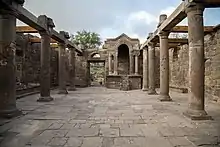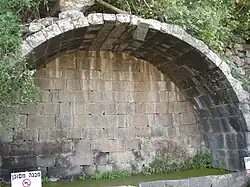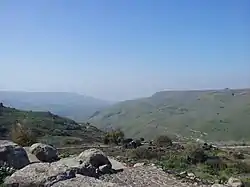Umm el-Qanatir
Umm el-Qanatir, also spelled Umm el-Kanatir (Arabic: ام القناطر, romanized: Umm al-Qanāṭir, lit. 'mother of the arches'), also known as Ein Keshatot (Hebrew: עין קשתות, lit. 'spring of the arches'), is an archaeological site on the Golan Heights, whose main phase is dated to the mid-5th–8th centuries.[1][2] Excavations have revealed a Roman-period settlement, first inhabited by pagans and later by Jews, who left behind the ruins of an exquisite synagogue when they abandoned the town after it being destroyed by the catastrophic 749 earthquake.[1] The site is located 10 kilometres east of the Dead Sea Transform,[3] one kilometre southwest of Natur.[1]
 Partially reconstructed Umm el-Qanatir synagogue (August 2016) | |
 Shown within the Golan Heights  Umm el-Qanatir (the Golan Heights) | |
| Alternative name | Ein Keshatot |
|---|---|
| Region | Golan Heights |
| Coordinates | 32°50′58.92″N 35°44′16.18″E |
| Type | Settlement |
| History | |
| Abandoned | 749 CE |
| Periods | Roman period to Umayyad period |
| Cultures | Hellenistic, Pagan, Jewish |
| Site notes | |
| Condition | In ruins; partially reconstructed |
| Public access | Yes |
| Website | Ein Keshatot |
Identification attempts based on Jewish sources have led to two possible ancient names: Kantur, mentioned by Rabbi Menachem di Luzano in his book Ma'arikh (16th/early 17th century);[4] and Qamtra, the name of a place mentioned in the Talmud and with a Jewish past dating back to the Byzantine period.[2][5]
Etymology

The Arabic word qantara, pl. qanatir, can mean arch,[6] a bridge built of stone or masonry, an aqueduct or a dam, and a high building.[7] The name of the site derives from its location 200 metres from a natural spring that flows from the cliff into three basins that were once topped by monumental basalt arches, one of which has survived.[1]
Some Israeli authorities are starting to use the new Hebrew name of Ein Keshatot ("Spring of the Arches"), such as seen on official postage stamps.[8] The site is also being advertised as Rehavam's Arches, so named after former Israeli Minister of Tourism, Rehavam Ze'evi.[9]
History
Ancient town: pagan, then Jewish

The site is believed to have been a pagan Roman town that venerated the nearby spring. Jews began to settle in the vicinity in 23 BCE.[10] Early Jewish inhabitants of Umm el-Qanatir established a flax industry there, using the water for washing and whitening flax from which they wove fine cloth. The textiles were sold to wealthy residents in the nearby towns of Sussita and Beit Saida.[1] The villagers may have engaged in mixed farming, and raised sheep and olives, although no terracing has been found.[1]
The catastrophic 749 earthquake brought the settlement to an end.[2]
Ancient synagogue

Use in antiquity (5th-8th century)
It was apparently in the fifth century that the Jewish residents built a large synagogue, which they embellished during the sixth century.[1] The building was 18 meters (59 feet) long by 13 meters (43 feet) wide and calculated to have been 12 meters (39 feet) high, making it one of the largest of at least 25 ancient synagogues discovered in the region. It was destroyed in the Golan earthquake of 749, when the Jewish inhabitants left the shattered settlement.[1]
Rediscovery
The existence of a synagogue at the site was first documented in 1884, by Laurence Oliphant and Gottlieb Schumacher.[12] Amid ruined walls and large blocks of stone, Oliphant discovered a stone carving of a vulture, a fragment of a cornice, a large triangular slab that he believes was placed on the lintel of the main entrance and fragments of Corinthian capitals.[12] The vulture, a well-known motif in ancient Jewish art, particularly in the Golan and Galilee, is visible on a double column and on the front gable of the synagogue and might come from the same workshop as the decorated Torah shrine base from 'En Samsam, another Golan Heights site.[13][14][15]
Reconstruction

Reconstruction of the synagogue is now complete thanks to Yehoshua Dray and Haim Ben-David of Kinneret Academic College and Bar-Ilan University.[1] The project, inaugurated in 2003, used special high-tech computer technology to code and digitally record the stones. Blocks were then labelled with RFID chips and a special crane lifted and inserted them in the correct sequence.[16] With the help of this technology, the synagogue has been restored with great accuracy.[17]
See also
- Ancient synagogues in Palestine (covers entire Palestine region)
- Oldest synagogues in the world
References
- S. G. Rosenberg (February 19, 2009). "The synagogue of Umm el-Kanatir". Jerusalem Post.
- Stephen Rubin, Discovering Jewish History on the Golan Heights, on the website of The Tower and The Tower Magazine
- Wechsler, Neta; Katz, Oded; Dray, Yehoshua; Gonen, Ilana (July 2009). "Estimating location and size of historical earthquake by combining archaeology and geology in Umm-El-Qanatir, Dead Sea Transform". Natural Hazards. Springer Media. 50: 27–43. doi:10.1007/s11069-008-9315-6. S2CID 140623417. Retrieved 10 July 2020.
- Eli Yassif, Intertextuality in folklore: pagan themes in Jewish folktales from the Early Modern Era, for the correct spelling and century
- Urman, Dan and Flesher, Paul Virgil McCracken Ancient Synagogues: Historical Analysis and Archaeological Discovery, p. 549, Brill, 1998, 2nd edition, series: Studia Post Biblica, No 47 (Themes in Biblical Narrative) (v. 1 & 2), ISBN 9789004112544. Accessed 5 September 2018.
- Palmer, E.H. (1881). The Survey of Western Palestine: Arabic and English Name Lists Collected During the Survey by Lieutenants Conder and Kitchener, R. E. Transliterated and Explained by E.H. Palmer. Committee of the Palestine Exploration Fund. p. 23. Retrieved 10 July 2020.
- van Donzel, Emeri Johannes (1994). Islamic Desk Reference. BRILL. p. 24. ISBN 9789004097384. Retrieved 10 July 2020.
- Israel Post, Israel's National Heritage – Landmarks: Ein Keshatot, Golan, February 11, 2014, via virtualstampclub.com. Accessed 5 September 2018.
- To Rehavam's Arches, on the Israel Ministry of Tourism website. Accessed 5 September 2018.
- Amy Gurtler, Julie Haimann, Caroline Simmons, "Syrian-Israeli peace in the Golan: No walk in the park", IMES Capstone Serie, G. Washington University, Elliot School of International Affairs, Inst. for Middle East Studies, April 2010). Accessed 10 July 2020.
- Yigal Kipnis (2013). The Golan Heights. London and New York: Routledge. p. 244.
- Studia Post Biblica, Ancient Synagogues: Historical Analysis and Archaeological Discovery, Dan Urman and Paul V.M. Flesher
- Rachel Ḥachlili, Ancient Jewish Art and Archaeology in the Land of Israel: Motifs of Jewish Art, p. 333, accessed 5 September 2018
- Rachel Hachlili, Ancient Synagogues - Archaeology and Art: New Discoveries and Current Research, p. 147, Brill, 2013, series: Handbook of Oriental Studies: Section 1; The Near and Middle East (Book 105), ISBN 978-9004257733, accessed 5 September 2018
- Torah shrine base, En Samsam, Golan Heights, accessed 5 September 2018
- For the Love of the Land: The Golan Heights
- Technology bringing history back to life
External links
- Photos of Umm el-Kanatir from the Manar al-Athar photo archive